Vocational and professional education and training (VPET) is becoming increasingly important in mainland China because it can provide a technically skilled and trained labor force to sustain and enhance social and economic development (Yu et al., 2025). Therefore, the government of the People’s Republic of China (PRC) has reformed the VPET system in an attempt to improve educational quality (Liu & Hardy, 2023; Wu & Ye, 2018). Li et al. (2024) note that the VPET reform has addressed two themes, namely, tertiarization—upgrading and elevating the status of VPET—and academization—incorporating VPET into academic education. In other words, the PRC government has set the academic qualifications and standards for VPET and academic education at the same level. Nevertheless, VPET is still positioned at the bottom of the education system and faces considerable social prejudice in mainland China (Wang & Wang, 2022). Social prejudice—VPET as the pathway for underachievers to learn low-skilled and manual labor (Stewart, 2015)—causes VPET to disproportionately attract low-performing students with weak self-efficacy and learning motivation (Chu et al., 2015; Coledam & Frotta, 2022; Wang & Guo, 2019; Wang & Wang, 2022). Moreover, the public expenditure on VPET is significantly lower than that allocated to academic education in mainland China (Yu et al., 2025), thereby keeping the salary level of VPET teachers low (Liao, 2024). All of these situations make it difficult for the VPET to attract and retain mission-driven, professional, and high-quality teachers (Wu & Ye, 2018; Yu et al., 2025).
According to Zhang et al. (2023), fostering teacher social recognition can be an approach to address this problem because social recognition, which involves public acknowledgment and appreciation of one’s positive aspects, has been identified as a significant factor positively associated with teacher commitment (Movessian, 2018), professionalism (Zhang, 2024), and quality of teaching (OECD, 2012). Therefore, understanding the factors that can cultivate the social recognition of VPET teachers in mainland China is crucial. Taking the impacts of external accountability into account may help answer this question because external accountability, which is defined as the formal measures holding teachers responsible and answerable for their performance to stakeholders such as students and parents (Rosenblatt & Wubbels, 2021), has been used to ensure teacher quality and professionalism, but it may institutionally shape how teachers perceive being recognized (Burns, 2016; Li & Tsang, 2023; Zhang & Tsang, 2021). Moreover, calling, which is commonly referred to as shiming (mission as direct translation) in Chinese societies (Zhang, Herrmann, et al., 2015), can also be an important factor affecting teacher social recognition. This is because calling embodies human subjectivity, enabling teachers to reflexively exercise their professional autonomy in enacting the moral values and purposes of teaching (Tsang et al., 2025) and, in turn, cultivating public acknowledgment and appreciation for their competence and merits (Zhang et al., 2025). Nevertheless, few empirical studies have examined the effects of external accountability and calling on teacher social recognition, especially in the VPET setting. Consequently, the understanding of how VPET teachers gain social recognition remains limited. Accordingly, this study contributes to the literature by investigating the relationships among external accountability, calling, and teacher social recognition among VPET teachers in Chinese vocational high schools.
Literature Review
Teacher Social Recognition
In general, social recognition refers to the act of publicly acknowledging one’s positive aspects. In the context of teaching, it particularly signifies the acknowledgment and appreciation of teachers’ performance and achievements (Andrews, 2011). According to Honneth’s (1995) theory, social recognition comprises three distinct forms, namely, love or care (emotional concerns for one’s well-being and needs), respect (recognition of equality, basic rights, and dignity), and social esteem (the acknowledgment of one’s achievements and contributions). Applying this theory, Zhang et al. (2023) report that teacher social recognition in Chinese societies primarily consists of care and social esteem. In other words, being recognized implies (1) teachers receiving significant concern for their needs and well-being and (2) experiencing acknowledgment and appreciation for their teaching excellence and competence. Thus, social recognition can manifest positive effects on teachers’ identity (Adams, 2013), self-efficacy (Bandura, 1993), commitment (Mackenzie & Nwafor, 2020), satisfaction (Ellis & Bernhardt, 1992), professionalism (Zhang, 2024), and well-being (Zhang et al., 2024).
External Accountability and Teacher Social Recognition
Social recognition serves not only as a fundamental human need but also as a key organizational means for motivating and rewarding teachers (Honneth, 2012; Zhang et al., 2023). There are various organizational measures to give recognition to teachers, such as monetary awards and promotions (Chism, 2006). These organizational measures have been tightly coupled with external accountability in the education system of mainland China (Zhang et al., 2023). For instance, in the Chinese education system, performance pay and an honorable title are awarded to teachers who meet key performance indicators, such as achieving high student test scores, winning teaching competitions, and publishing articles (Song et al., 2013; Wang et al., 2014). Receiving the performance pay and honorable title can signify a teacher’s professional competence, thereby enhancing his or her professional status and authority in the Chinese education system (Lo et al., 2015).
In mainland China, external accountability functions not only as a coercive mechanism for teachers but also as an enabling force that enhances teachers’ social recognition, promoting their self-monitoring to uphold prescribed professional standards and social expectations (Qin, 2019; Zhang & Tsang, 2021). For example, when Li and Tsang (2023) observe reduced job burnout among teachers in mainland China under external accountability, they attribute this effect to accountability measures such as performance pay and honorary titles, which can explicitly recognize professional competence and merits. Similarly, Zhang and Tsang (2021) report that teachers in mainland China generally view external accountability measures positively because they perceive the measures as pathways through which they can achieve social recognition. Accordingly, external accountability is likely to foster teacher social recognition in mainland China. Therefore, the following hypothesis is proposed.
Hypothesis 1 (H1): External accountability is positively associated with teacher social recognition.
Roles of Calling: The Mediating Effects of a Sense of Calling and Living a Calling
The concept of calling has its own religious roots, especially in Christianity. In the religious sense, calling refers to receiving and answering God’s summons (Madero, 2020). However, in modern societies, people secularly use the concept to refer to a sense of duty and life purpose arising from social expectations or personal desires (Willemse & Deacon, 2015). Thus, Dik and Duffy (2009, p. 427) define calling as “a transcendent summons, experienced as originating beyond the self, to approach a particular life role in a manner oriented toward demonstrating or deriving a sense of purpose or meaningfulness and that holds other-oriented values and goals as primary sources of motivation.” This definition highlights three core elements of calling, namely, transcendent summons, purposeful work, and prosocial orientation (Dik et al., 2012). In Chinese societies, calling is translated into shiming as the perceived need to fulfill a mission or an expectation from a higher power, such as family, superior authorities, or a transcendent power (Zhang, Dik, et al., 2015). According to Zhang, Herrmann, et al. (2015), in Chinese societies, calling consists of altruism (the tendency to help others and make a difference in society through work and career), guiding forces (the subjective feelings of a guiding reference for career development), and meaning and purpose (the connection between a calling and a broader sense of meaning in life).
To some extent, calling serves as a factor affecting teacher social recognition. Research indicates that when teachers have a sense of calling, i.e., perceiving a calling to the teaching profession, they tend to find their work meaningful and personally significant (Willemse & Deacon, 2015; Zhang et al., 2025). This perception can enhance their teaching motivation and commitment (Bullough & Hall-Kenyon, 2011, 2012), leading teachers to exhibit greater passion and devotion toward fostering students’ holistic development (Rampa, 2012). Moreover, they may demonstrate heightened resilience in overcoming challenges to achieve high-quality teaching (Wen et al., 2024). These qualities, such as passion, devotion, resilience, and the pursuit of excellence, are socially recognized as hallmarks of professional teaching excellence (Day, 2018). In other words, a sense of calling can be positively associated with teacher recognition.
A sense of calling is distinct from living a calling, which is defined as the actualization of one’s calling in his or her current career (Duffy et al., 2018). Research demonstrates that individuals who perceive a calling but fail to live it out may not fully attain its associated benefits (Duffy et al., 2013; Duffy & Autin, 2013; Duffy et al., 2012). This occurs because living a calling enables teachers to authentically verify and actualize the professional self (Bloom et al., 2021; Madero, 2021), resulting in enhanced job performance, profound positive emotions, and occupational well-being (Duffy et al., 2012; Duffy et al., 2018; Zhang et al., 2025). These outcomes may collectively serve as tangible evidence by which the public assesses teachers’ competence and contributions (Fauziah et al., 2021). Therefore, like a sense of calling, living a calling may be positively related to teacher social recognition.
The literature suggests that extrinsic factors such as job stability and long holidays, rather than a calling, are primary motivations for becoming VPET teachers in mainland China (Li, 2017). However, this dynamic may shift when external accountability is structured to enable teachers to identify and enact the core values and purposes of their work (Lee et al., 2024). The PRC government has implemented accountability measures designed to ensure that teachers understand and commit to the shide as a framework of professional ethics and moral values that serve as a guide for self-regulation. These measures not only punish violations but also reward those who exemplify high standards of shide. Therefore, accountability may act as a positive guiding force, helping Chinese teachers cultivate altruism and recognize the connection between their work and their personal sense of meaning and purpose. Furthermore, it can provide a mechanism for them to achieve a sense of duty and life purpose through teaching. This function of accountability is particularly critical given what Green (2023) describes as the “rational chaos” of the Chinese education system, characterized by vague, ambiguous, and frequently changing rules and procedures. This environment can undermine teachers’ sense of safety and certainty in teaching, discouraging them from striving for their values and purposes. By providing clearer goals, direction, and regulations, external accountability may create the structured, safe, and certain conditions necessary for teachers to enact their calling in alignment with systemic requirements (Li & Tsang, 2023). Therefore, under these specific conditions, external accountability may actively foster both a sense of calling and the ability to live it out among teachers in mainland China.
Given that a sense of calling and living a calling may predict teacher social recognition and be impacted by external accountability, they may function as mediators in the relationship between external accountability and teacher social recognition. Accordingly, the following hypotheses are formulated.
Hypothesis 2 (H2): A sense of calling will mediate the relationship between external accountability and teacher social recognition.
Hypothesis 3 (H3): Living a calling will mediate the relationship between external accountability and teacher social recognition.
Chain Mediating Effect of a Sense of Calling and Living a Calling
Duffy et al. (2018) emphasize that a sense of calling and living a calling are interdependent constructs, asserting that “to live out a calling one must perceive a calling” (p. 426). It positions a sense of calling as an antecedent of living a calling. To some extent, the literature provides support for this claim, as research has demonstrated that living a calling can significantly mediate the effects of a sense of calling on outcomes such as job satisfaction and well-being (e.g., Duffy et al., 2012; Duffy et al., 2017). Extending this logic to the teaching context, it can be inferred that living a calling can mediate the effects of a sense of calling on teacher social recognition. In other words, when teachers have a sense of calling, they are more likely to receive greater social recognition because their ability to live out the calling is increased. This suggests that a sense of calling and living a calling are likely serial mediators in the relationship between external accountability and teacher social recognition. Therefore, the following hypothesis is proposed.
Hypothesis 4 (H4): A sense of calling and living a calling play a chain mediating role between external accountability and teacher social recognition.
On the basis of this review of the literature, the research framework of this study is proposed (see Figure 1).
Figure 1
Hypothesized chain mediation model
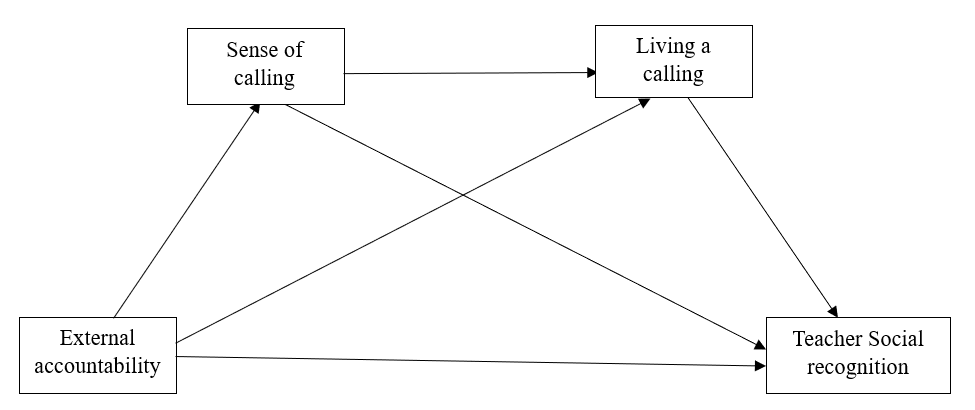
Method
Participants
The study sampled participants via the social network of the research team. The research team created an online survey and sent the web link to vocational high school teachers whom the team members knew. The research team invited these teachers to complete the survey and share it with other vocational high school teachers. A total of 210 vocational high school teachers completed the questionnaire. Among them, 6 questionnaires were excluded from the data analysis because they were incomplete or invalid, resulting in a final sample of 204 teachers. Among this sample, 38.2% were male and 61.8% were female. On average, the participants were 35.62 years old (SD = 8.089) and had 10.56 years of teaching experience (SD = 7.976). The sample was highly educated, as most of them held a master’s degree (59.8%) or a doctoral degree (38.7%), and a small minority held only a bachelor’s degree (1.5%). These characteristics suggested that the sample was relatively young and early in their teaching careers but possessed a high level of formal education. In terms of geographical distribution, many of the participants were from Guangdong Province (24.5%), followed by Zhejiang Province (17.6%), Sichuan Province (13.7%), Beijing city (13.2%), and others (31%; including Shandong Province, Shanxi Province, Guangxi Province, Yunnan Province, Tianjin city, Gansu Province, Jilin Province, Anhui Province, Jiangsu Province, Liaoning Province, Hebei Province, Henan Province, Qinghai Province, Guizhou Province, Chongqing city, Shaanxi Province, Hainan Province, Hubei Province, Hunan Province, and Fujian Province).
Measures
External Accountability. External accountability was measured by a subscale of the Chinese version of the personal accountability measure (PAM-Ch) (Tsang et al., 2023). This subscale has 6 items to assess the perceived external accountability of teachers. A sample item was “Give school management a report on the extent to which you reached your goals at work”. All the items were rated on a 5-point Likert scale ranging from 1 (completely disagree) to 5 (completely agree). In this study, the Cronbach’s alpha for the PAM-Ch subscale was 0.913.
A Sense of Calling. A sense of calling was assessed by Dik et al.’s (2012) Brief Calling Scale (BCS), which consists of 4 items. Each item was rated on a 5-point Likert scale from 1 (not at all true of me) to 5 (totally true of me). A sample item was “I have a calling to a particular kind of work.” In this study, the Cronbach’s alpha of the BCS was 0.821.
Living a Calling. Duffy et al.’s (2012) Living Calling Scale (LCS) was applied to investigate living a calling in this study. There were 6 items, and each item was rated on an 8-point Likert scale from 1 (strongly disagree) to 7 (strongly agree), with 8 indicating “not applicable—I don’t have a calling”. A sample item is “I have regular opportunities to live out my calling”. In this study, the Cronbach’s alpha of the LCS was 0.911.
Teacher Social Recognition. The Teacher Recognition Scale (TRS), developed by Zhang et al. (2023), was adopted to measure teacher social recognition. The TRS contains 10 items assessing two dimensions of teacher social recognition, namely, recognition for care (4 items; a sample item: “At my school, other persons show me their concern and caring to me when I meet difficulty in life”; Cronbach’s alpha = 0.969) and recognition for social esteem (6 items: a sample item: “At my school, other people always show me their acknowledgment and praise for my performance”; Cronbach’s alpha = 0.967). The Cronbach’s alpha of the entire TRS was 0.973 in this study.
Data Analysis
SPSS 30.0 was used to analyze the data. First, Harman’s single-factor test and variance inflation factor (VIF) values were examined to ensure that there was no serious common method deviation or multicollinearity concern. Second, descriptive statistics and Pearson correlation analysis were computed to preliminarily analyze the relationships between variables. Third, linear regression analysis was conducted to examine the effect of external accountability on teacher social recognition, and PROCESS Model 6 was used to test the mediating effects of a sense of calling and living a calling between external accountability and teacher social recognition.
Findings
Description and Correction
Table 1 presents the mean, standard deviation, and correlation among teacher social recognition, external accountability, sense of calling, and living a calling. The results suggested that teacher social recognition was significantly related to external accountability (r = 0.633, p < 0.001), sense of calling (r = 0.460, p < 0.001), and living a calling (r = 0.526, p < 0.001). Moreover, external accountability was significantly related to a sense of calling (r = 0.525, p < 0.001) and living a calling (r = 0.479, p < 0.001). The results also indicated a strong positive relationship between a sense of calling and living a calling (r = 0.722, p < 0.001).
Table 1
Mean, standard deviation, and correlations among the variables
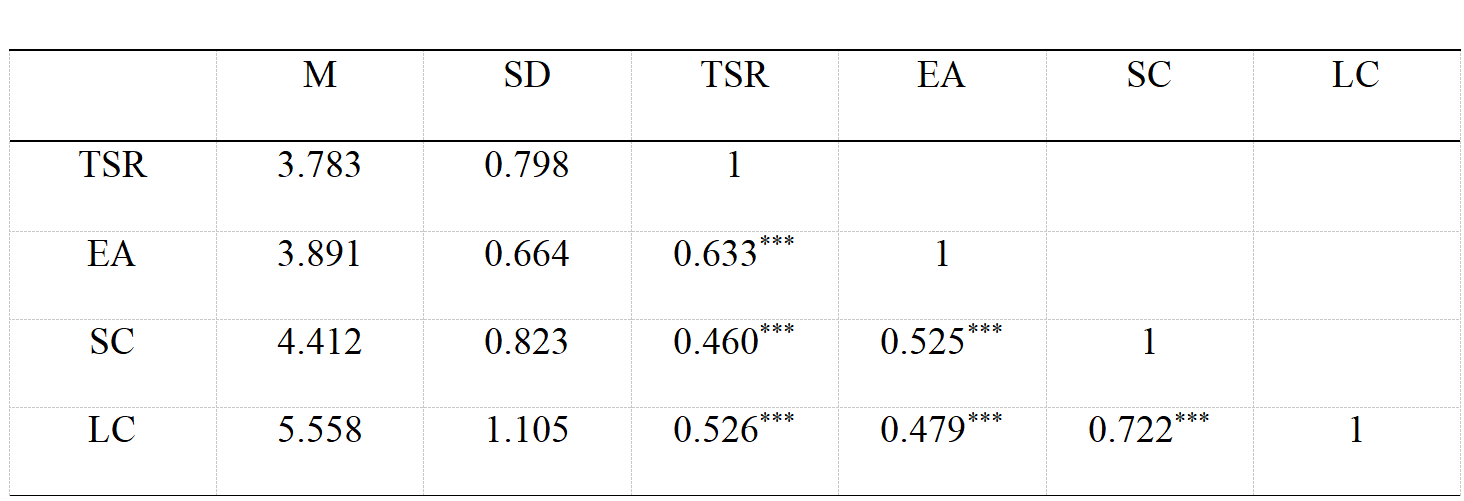
Note: TR represents teacher social recognition, EA represents external accountability, SC represents a sense of calling, and LC represents living a calling
*** p < 0.001 (2-tailed)
Chain Mediation Analysis
To primarily examine the mediating effect of a sense of calling and living a calling on the relationship between external accountability and teacher social recognition, multiple linear regressions were computed. As Table 2 indicates, after controlling for gender, age, and teaching experience, external accountability was significantly related to a sense of calling (ß = 0.527, t = 8.710, p > 0.001), living a calling (ß = 0.159, t = 2.774, p > 0.01), and teacher social recognition (ß = 0.506, t = 8.037, p > 0.001). Moreover, the results suggested that a sense of calling was significantly related to living a calling (ß = 0. 630, t = 10.967, p > 0.001) but was not significantly associated with teacher social recognition (ß = -0.022, t = -0.280, p < 0.05). In addition, living a calling was significantly associated with teacher social recognition (ß = 0.299, t = 3.860, p > 0.001). These results implied that external accountability was positively related to teacher social recognition and that this relationship was mediated by living a calling and chain mediated by both a sense of calling and living a calling. Therefore, H1 was supported.
Table 2
Linear regression analysis of the relationships among external accountability, a sense of calling, living a calling, and teacher social recognition
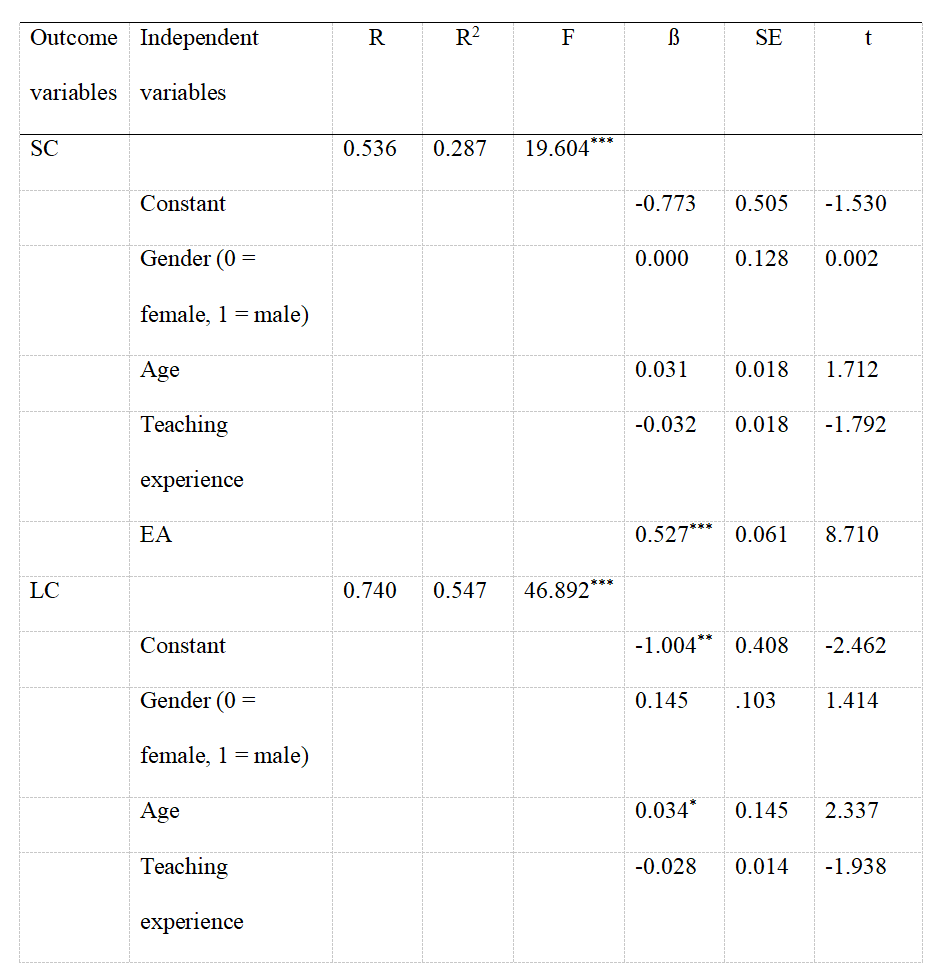
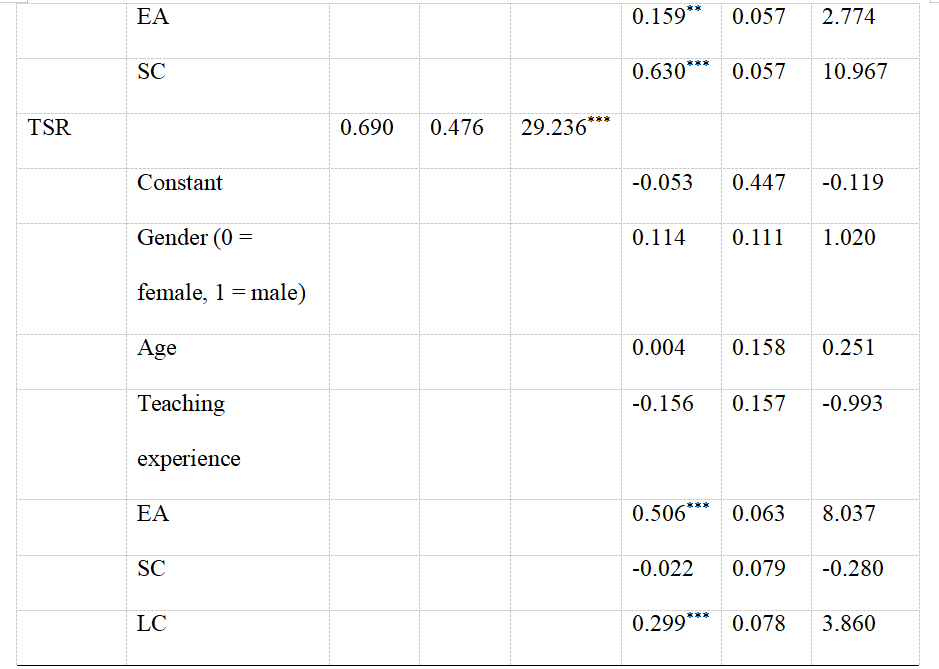
Note: TSR represents teacher social recognition, EA represents external accountability, SC represents a sense of calling, and LC represents living a calling
* p < 0.05**p <0.01*** p < 0.001
To further test the mediating effects, PROCESS Macro Model 6 was used, with the application of the biased-corrected percentile bootstrap method (5,000 replications). The results suggested that the direct effect of external accountability on teacher social recognition was 0.506 (95% CI [0.382, 0.630]), whereas the indirect effect was 0.135 (95% CI [0.033, 0.283]). In other words, a sense of calling and living a calling could mediate the effect of external accountability on teacher social recognition. According to Table 3, Path 2 (EA LC TR, effect = 0.047, SE = 0.030, 95% CI = [0.000, 0.115]) and Path 3 (EA SC LC TR, effect = 0.099, SE = 0.049, 95% CI = [0.017, 0.210]) were significant, while Path 1 (EA LC TR, effect = 0.047, SE = 0.030, 95% CI = [0.000, 0.115]) was insignificant. The results indicated a significant mediating effect of living a calling and a significant chain-mediating effect of sense of calling and living a calling on the effect of external accountability on teacher social recognition (see Figure 2). Accordingly, H3 and H4 were supported, whereas H2 was rejected.
Figure 2
Relationships between external accountability, a sense of calling, living a calling, and teacher social recognition
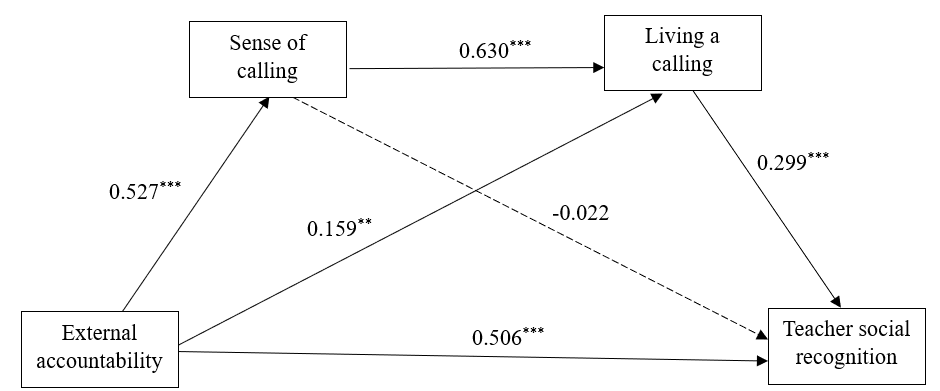
Note: Control variables include gender, age, and teaching experience,*** p < 0.01*** p < 0.001
Table 3
Test of mediating effects
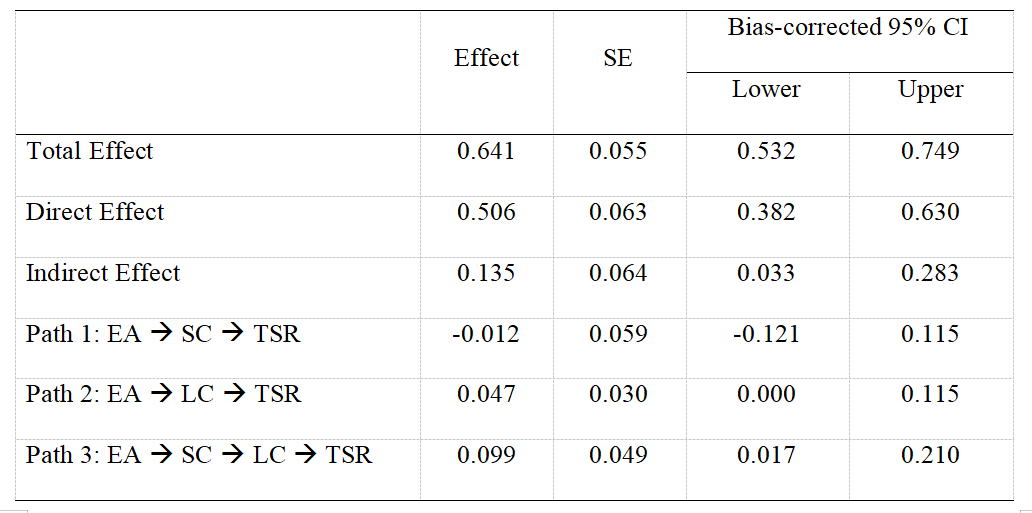 Note: TSR represents teacher social recognition, EA represents external accountability, SC represents a sense of calling, and LC represents living a calling
Note: TSR represents teacher social recognition, EA represents external accountability, SC represents a sense of calling, and LC represents living a calling
Discussion
In mainland China, the status of VPET has been inferior to that of academic education (Wu & Ye, 2018; Xiong, 2010; Yu et al., 2025). In addition to disproportionately enrolling low-performing students, this inferiority makes it difficult for the VPET to attract and retain mission-driven, professional, and high-quality teachers (Koreshnikova et al., 2018). Therefore, there is an urgent need to increase the social recognition of VPET teachers, thereby enhancing their teaching commitment (Movessian, 2018), professionalism (Zhang, 2024), and quality of teaching (OECD, 2012). Thus, this study aims to determine whether external accountability can foster teacher social recognition in mainland China, as numerous external accountability measures have been implemented to ensure and enhance teacher professional competence and quality through holding them answerable and responsible to stakeholders (Li & Tsang, 2023; Rosenblatt & Wubbels, 2021; Zhang & Tsang, 2021). Although external accountability has been criticized as a cohesive mechanism that is used to control and monitor teachers, leading to teacher disempowerment (Tsang, 2019; Wright, 2020), this study supports Li and Tsang (2023) and Zhang and Tsang (2021), who observe that external accountability can be an enabling force in mainland China. This is because the findings show that external accountability can directly enhance teachers’ social recognition and indirectly facilitate them in perceiving and living out a calling.
Although the findings generally support the hypothesized research framework, especially the mediating effect of living a calling and the chain mediating effect of both a sense of calling and living a calling, the results of this study indicate that the mediating effect of a sense of calling is insignificant. These findings are similar to those reported by Duffy and his colleagues (e.g., Duffy et al., 2012; Duffy et al., 2017). Their studies indicate that living a calling can fully mediate the effect of a sense of calling. Accordingly, as Duffy et al. (2018) argue, simply perceiving a calling may not lead to positive outcomes unless teachers can also live it out. Therefore, when living a calling is controlled, a sense of calling alone becomes insufficient for generating positive teacher outcomes. As a result, it is important to create an environment that enables teachers to enact their calling rather than solely focusing on cultivating their sense of calling.
This study has both theoretical and practical implications. Theoretically, it demonstrates the potential for implementing external accountability in the context of China’s VPET system by indicating the mechanism through which this promotes teacher social recognition via the chain mediation of a sense of calling and living a calling. It also contributes to enriching the empirical literature on external accountability, teacher social recognition, and calling. Practically, the findings suggest that decisions on administration and educational policies at the school level should prioritize the active provision of supportive environments to help teachers transform their intrinsic sense of calling into daily practice rather than being limited in implementing accountability. Finally, the results highlight the need for institutional designs to provide teachers with sufficient autonomy, resources, and recognition mechanisms to realize their professional values, thereby addressing the challenges of attracting and retaining high-quality vocational teachers and enhancing the status and quality of VPET in China.
Two major limitations of the study are highlighted here. First, the study relies only on participants selected through a nonprobability sampling method, resulting in a small sample size. In other words, the findings may not represent the whole population of vocational high school teachers in mainland China. Thus, further research should replicate the study using a larger sample selected by a probability sampling method. Second, the vocational high school teacher is the only type of VPET teacher in mainland China. Therefore, further research should examine the relationships among external accountability, calling, and social recognition among other types of VPET teachers, such as those teaching in vocational colleges. Moreover, researchers can conduct comparative studies to understand the differences between different types of VPET teachers in mainland China, thereby providing a more comprehensive account of the effects of external accountability on teacher social recognition by calling.


